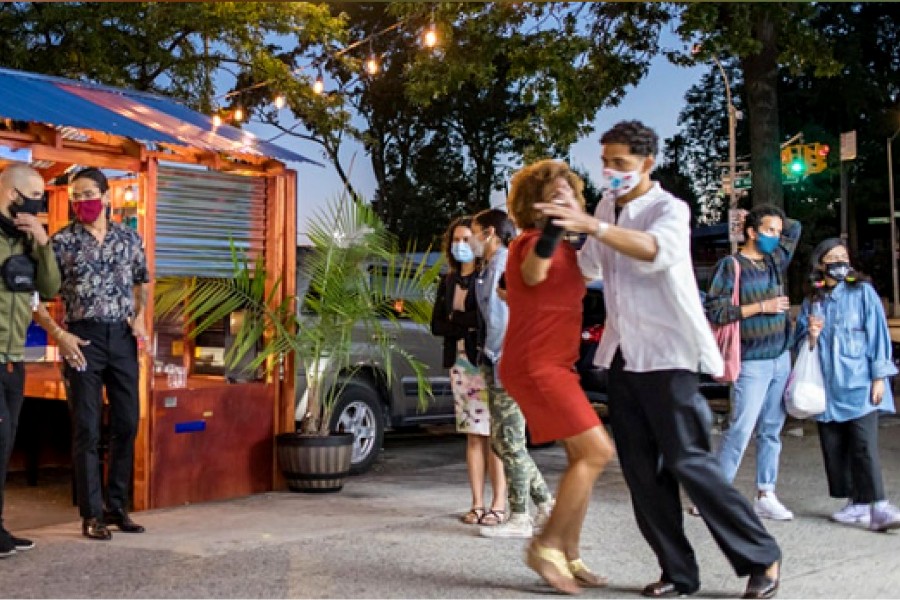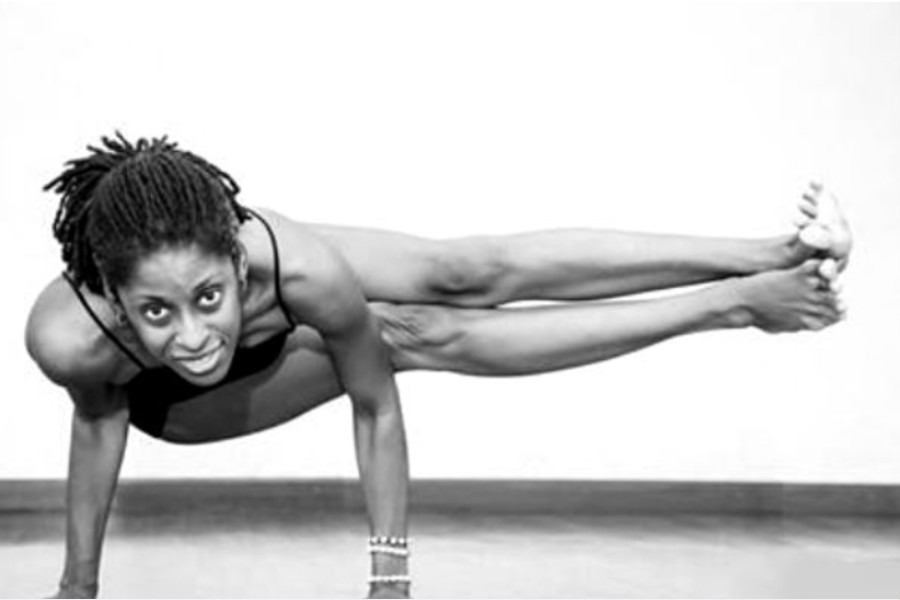
New York City Public Design Commission (PDC) Executive Director Sreoshy Banerjea today released “Designing New York: Streetscapes for Wellness.”
A landmark study of how innovative public realm initiatives focused on wellness can inform and inspire the future of New York City’s streetscapes.
Developed in collaboration with the New York Chapter of the American Society of Landscape Architects, the Fine Arts Federation of New York, the New York City Department of City Planning’s Urban Design Office, a broad interagency steering committee, and dozens of contributors who are involved in the planning, design, maintenance, and programming of streets, “Streetscapes for Wellness” reviews approximately 30 case studies from New York City and a handful of other communities to suggest ways of reimagining public spaces to further social and environmental justice while enhancing public health. An analysis of community health data, provided by the New York City Department of Health and Mental Hygiene, underscores the importance of designing and building high-quality public spaces to address inequities across New York City. The report was led and authored by Jenna Miller, deputy director, urban design and policy at PDC.
“Well-designed public space is a critical part of improving our collective physical, mental, and emotional health,” said New York City Mayor Eric Adams. “As the city continues to recover strongly, our administration is planning a city that is more resilient, not only to climate change but also to future public health challenges — and equity must be, and is, at the heart of that work. Every New Yorker, regardless of neighborhood or identity, deserves access to high-quality open spaces, and that’s what our administration is working to deliver.”
“The case studies in ‘Streetscapes for Wellness’ showcase ideas from some of our city’s most creative innovators, and they also inspire opportunities for growth,” said Deputy Mayor for Economic and Workforce Development Maria Torres-Springer. “This publication shows the great value of public-private partnerships and community collaborations. The lenses of wellness highlighted in this book — physical health, mental well-being, social adhesion, and environmental resilience —should continue to inform how we plan, design, maintain, and program our public realm for years to come. Investing energy into these efforts is central our administration’s goals of building a safer and more equitable and resilient city.”
“We know from the pandemic that the city’s built environment is critical to the health and well-being of New Yorkers. The ‘Streets for Wellness’ report shows what can happen when we reimagine public spaces to become people-first,” said Deputy Mayor for Operations Meera Joshi. “From a crisis, the city created meaningful public space changes that continue to make our streets and people thrive. We must look at these spaces only as starting points, as we move towards an even more vibrant public realm for all New Yorkers.”
“Our streetscapes are open spaces that functioned as a lifeline to many New Yorkers and small businesses during the pandemic,” said New York City Public Design Commission Executive Director Sreoshy Banerjea. “We must continue to inspire creative placemaking on streets to help make New York City more equitable and accessible for all.”
“Streetscapes for Wellness” explores how a holistic, integrated approach for a safer public realm can help improve public health alongside aesthetics, usability, and public perception to support an inclusive and thriving urban environment and public life. The sudden onset of the COVID-19 pandemic spurred city agencies to think creatively about how to provide areas for safe public recreation and support local businesses.
The latest addition to PDC’s “Designing New York” series, this report advances goals outlined in “Rebuild, Renew, Reinvent: A Blueprint for New York City’s Economic Recovery,” for reactivating our city’s public realm and achieving streetscape vitality. “Streetscapes for Wellness” reinforces the Adams administration’s commitment to improving New Yorkers’ and communities’ health through the design and care of its streetscapes and adjacent public spaces. It follows major public realm efforts the administration has announced in just the last two months, such as New York City’s largest-ever holiday season-specific Open Streets plan, a groundbreaking study showcasing the economic benefits of expanded public space, and a comprehensive effort to cut red tape in the city’s capital construction process and deliver these projects more quickly and efficiently.
Though wellness is all too often associated with a commodified focus on personal growth that can be achieved with the help of a product or service, “Streetscapes for Wellness” reframes wellness through an urban design lens and poses the question, “Whose wellness are we talking about?” The case studies highlighted in the report showcase the importance of community-based initiatives and advocacy efforts, street stewardship, maintenance, and broad stakeholder engagement.
“Streetscapes for Wellness” showcases just a few of the ways in which public-private partnerships and community-driven designs have positively impacted the physical health, mental well-being, community adhesion, and environmental sustainability and resilience of our city. The report reframes wellness through these four urban-design-informed lenses of health and highlights how the holistic wellness of individuals, communities, and ecosystems can be improved through the design of public space. Further, “Streetscapes for Wellness” urges us to draw inspiration from the people and places surrounding us, to listen to local knowledge, to allow for flexibility and experimentation, to foster a continued sense of stewardship, and to design for wellness.
“Vibrant streetscapes are vital to a healthy city,” said New York City Department of Health and Mental Hygiene Commissioner Dr. Ashwin Vasan. “Streets designed to meet the unique needs of New York City’s diverse neighborhoods support the physical, mental, and social health of communities and keep us connected to our cultures and to each other.”
“Healthy and safe streets, and public spaces that encourage biking, eating, shopping, and strolling, are enlivening New York City,” said New York City Department of City Planning Director and City Planning Commission Chair Dan Garodnick. “The Department of City Planning is committed to working with our diverse communities as we continue together to build a city that supports the well-being of all 8.5 million New Yorkers. We are thrilled to contribute to this publication.”
“Streetscapes are arguably one of the city’s most readily accessed and underutilized public resources,” said New York City Department of Transportation Commissioner Ydanis Rodriguez. “Our street network is New York City’s largest public space — our collective front yard — yet for decades, we’ve dedicated most of this land to one primary use: the movement and storage of automobiles. Through programs like Open Streets and our innovative street and plaza designs, the NYC Department of Transportation is showing how we can reimagine our roads for better, alternative uses, contributing to public health and overall wellness. We are committed to continuing to deliver projects that foster vibrant community spaces, improve transit access and reliability, and ultimately help guide the city to a safer, more sustainable future.”
“These and other vital infrastructure projects would benefit greatly from the reforms DDC proposed in its ‘Blueprint 2022,’” said New York City Department of Design and Construction Commissioner Thomas Foley, P.E. “New delivery tools would empower the city to deliver these and thousands of other capital projects faster and more cost effectively.”
“New York City’s parks are vital to the health and well-being of New Yorkers,” said New York City Department of Parks and Recreation Commissioner Sue Donoghue. “When we reimagine where they meet the streets and sidewalks, they become extensions of the communities they serve.”
“Well-designed and programmed streets improve the well-being and health of New Yorkers and are critical tools to build social resiliency and community connectedness as we adapt to a changing climate,” said Mayor’s Office of Climate and Environmental Justice Executive Director Kizzy Charles-Guzmán. “I applaud the release of ‘Streetscapes for Wellness’ and public realm ideas to mitigate the urban heat island effect, manage our city’s stormwater, and offer spaces of much-needed respite.”
“All schools need safe space around their schools, not just in their schools,” said Alice Goodman, Senior Director of Policy & Partnerships at the NYC Department of Education’s Office of School Wellness Programs.
“Well-designed streetscapes are essential to improving the quality of life for New Yorkers,” said Signe Nielsen, Founding Principal of MNLA and former NYC Public Design Commission President. “Innovative, resilient and green design solutions can help reduce the heat-island effect, provide areas of respite and shade, increase social activities, and help people feel welcome and safe. The projects highlighted in this book show ways in which we can reimagine the future use and design of our streets for a long-term impact that democratizes public space.”
“Summer 2020 was this extraordinary moment to test out everything. People became more engaged in what the public realm is, or what it should be,” said Kaja Kühl, Co-Founder of Design for Six Feet and contributor to “Streetscapes for Wellness.”
“The design of our neighborhoods shapes our physical and mental health,” said Daniel McPhee, Executive Director of the Urban Design Forum. “Our streets are now places where neighbors can come together to share food, culture, and space with one another. This is the right moment for the city to promote healthy streets and equip communities to create even more of them.”
“If redesigning a street for wellness requires displacement of an unhoused neighbor, complex permit applications, finding funding for a roadblock, potential harm to small businesses, or worse, the risk of related legal enforcement—that redesign will not feel like it’s contributing to a community’s wellness,” stated Deborah Marton, Executive Director of Van Alen Institute and NYC Public Design Commissioner. “Streetscape plans need to account for differences across more or less well-resourced communities. To achieve true and equitable wellness across our city, we must meet the need for increased funding and additional social services some communities will require with streetscape plans that honestly address differences across neighborhoods.”
“Being in the neighborhood taught us about the community’s real challenges and how intersections between policy and public realm design impacts people’s experiences and lives—important knowledge to gain as designers and planners,” said Jing Liu, Co-Founder at architectural firm SO-IL and contributor to “Streetscapes for Wellness.”
“All young people, regardless of zip code or socioeconomic circumstances, should be able to go to school in a healthy, green community,” said Noelia M., a Class of 2023 student at the Washington Heights Expeditionary Learning School. “We want other students to see our work and realize they can also inspire change in their schools and communities.”
“This is a critical and powerful moment to evaluate the relationship and the disconnection between schools and streets,” said “Streetscapes for Wellness” contributor Molly Delano, Executive Director of Futures Ignite, a Washington Heights-based nonprofit organization that amplifies youth and community voices and strives for educational equity and climate justice.
“‘Streetscapes for Wellness’ is full of inspiring cases that show just how joyful and healthful streets can be—when, and only when, they are designed for people over cars,” said the team at Open Plans, a non-profit technology and advocacy organization that aims to transform the streets of New York City to be truly livable for its residents. “These cases show that communities are justified in demanding that cities reimagine their streets. Doing so is beneficial to everyday life in so many ways—improved mental health, more physical activity, less danger, stronger social bonds. This publication is a wealth of knowledge that decision-makers should use as both playbook and proof for livable, holistic street design.”
Become a Harlem Insider!
By submitting this form, you are consenting to receive marketing emails from: . You can revoke your consent to receive emails at any time by using the SafeUnsubscribe® link, found at the bottom of every email. Emails are serviced by Constant Contact








